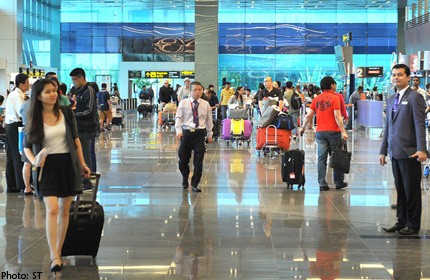Why Changi Airport must think big


SINGAPORE - Changi Airport's mega vision for the future, including a jewel of a mall to connect five terminals, expresses well the "aerotropolis" concept of urban planning scholar John Kasarda who sees the airport as a destination in its own right.
He argues for future cities to be built around airports (given the pivotal role of air travel) rather than the reverse.
For Singapore, the two are intertwined as dictated by geography, size and destiny. So integral is this interdependence to the global city - the entire economy depends on connectivity to throb - that the Government has underscored the fact that it will do its utmost to protect Singapore's hub status.
This lends urgency to Changi's task of thinking big and planning well ahead. History bears testimony to this approach with over half of the airport's land area reclaimed from the sea.
Construction in 1975 had 558 buildings and 4,096 graves giving way and swamps being cleared to usher in an era of around-the-clock travel and freighting that global business networks demand.
Since then, the airport has expanded progressively and terminals have been upgraded to cater to growing volumes and higher expectations.
Even greater changes are required now as its status as a connector hub is threatened by long-range aircraft, wrenching competition and traffic growth trends.
Indeed, Kuala Lumpur and Bangkok have a geographic edge in linking travellers from Europe to Asia. Like Dubai (which convinced Qantas to pull its hub out of Singapore), they are keen to expand.
Hence, Singapore's position as a hub is far from "inevitable or unassailable", as analysts have noted. Mr Lee Kuan Yew pointedly warned in 2004 that "Changi will be bypassed and we will lose our air-hub status" if key strategies are misguided.
With such high stakes, half measures might prove woefully inadequate and even disastrous. Studies show that airports that lose their hub status do not easily regain it.
The latest master- plan for Changi involves creating a huge new air terminal, with possibly its own MRT station, building a third runway at Changi East fed by 40km of taxiways - the length of the Pan Island Expressway from Tuas to Tampines - and diverting Changi Coast Road and a 60m-wide canal.
The effort, cost and upheaval will be enormous but there are well-grounded reasons for supporting sky-high ambitions.
With plans for a Moshe Safdie- designed mall (with a five-storey waterfall amid a lush indoor garden), new hotels, dining spots and shopping choices, the airport will offer much to residents and travellers alike.
A locals-friendly airport could certainly help to create more buzz there. But ensuring a smooth flow of all forms of traffic must rank paramount.

Get a copy of The Straits Times or go to straitstimes.com for more stories.